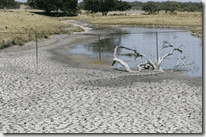With strong demand pushing up crop prices, economist thinks farmers may lose $8 billion
By Betsy Blaney
of The Associated Press
LUBBOCK, Texas — Randy McGee spent $28,000 in one month pumping water onto about 500 acres in West Texas before he decided to give up irrigating 75 acres of corn and focus on other crops that stood a better chance in the drought.
He thought rain might come and save those 75 acres, but it didn’t, and days of triple-digit heat sucked the remaining moisture from the soil. McGee walked recently through rows of sunbaked and stunted stalks, one of thousands of farmers counting his losses amid record heat and drought this year.
The drought has spread over much of the southern U.S., leaving Oklahoma the driest it has been since the 1930s and setting records from Louisiana to New Mexico. But the situation is especially severe in Texas, which trails only California in agricultural productivity.
McGee is still watering another variety of corn, cotton and sorghum, but the loss of nearly one-sixth of his acres after spending so much on irrigation weighs on him.
“Kind of depressing,” the 34-year-old farmer said. “You use that much of a resource and nothing to show for it. This year, no matter what you do, it’s not quite enough.”
About 70 percent of Texas rangeland and pastures are classified as in very poor condition, which means there has been complete or near complete crop failure or there’s no food for grazing livestock. The crop and livestock losses could be the worst the state has seen — perhaps twice the previous single-year record of $4.1 billion set in 2006, said David Anderson, an economist with Texas AgriLife Extension Service.
Part of the reason for the high dollar figure is that while farmers have lost a lot, the corn and other products they are losing are worth more this year. Strong global demand and tight supplies have helped push up prices for commodities like corn, cotton, wheat and beef.
Cotton supplies are low worldwide, and U.S. cattle numbers are the lowest since the 1950s. Livestock farmers and ethanol producers are competing for corn, driving up those prices, and wheat is costing more in part because Russia banned exports after a drought there last summer.
Cotton and corn are selling for more than two-and-a-half times what they did five years ago, and the price of wheat is more than one-and-a-half times what it was in 2006.
“This was a year farmers might have done well,” Anderson said.
Consumers will eventually see the cost of the drought passed on to them, although it’s hard to say by how much since processing, marketing, transportation and other costs play a big role in retail prices, he said.
Texas’ economy will take a more direct hit. Agriculture accounted for $99.1 billion of Texas’ $1.1 trillion economy, or 8.6 percent, in 2007, the most recent year data on food and fiber was available from the extension service. Losses in that sector have a ripple effect that’s about twice the amount of the actual agricultural loss.
“That’s a fairly substantial portion of the Texas economy that’s going through this hardship,” Anderson said.
http://www.news-sentinel.com/apps/pbcs.dll/article?AID=/20110730/BUSINESS/107300342


Deprecated: strpos(): Passing null to parameter #1 ($haystack) of type string is deprecated in /home/agriviek8Qv/agriviet.net/public_html/wp-includes/comment-template.php on line 2522